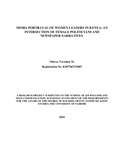| dc.description.abstract | The main objective of this study was to establish how the media portrays women leaders in
Kenya, with a focus on the narratives of female politicians and newspaper articles. Specifically,
the study investigated the frames used by media to cover prominent women leaders in Kenya and
analyzed the consequences of the media framing of women leaders on their political and public
leadership. To achieve the objectives, the study addressed three research questions; first, the
experience of prominent women leaders with regard to media coverage, Secondly, frames used
by media to cover prominent women leaders in Kenya, Lastly, the effect of media framing of
women leaders in Kenya on their political and public leadership. The research adopted a
qualitative research design. The study targeted women who have served at the national level in
an appointive or representation position in President Uhuru Kenyatta or former President Mwai
Kibaki administrations. The theoretical foundation of the study is Agenda Setting and Media
framing. Data was collected by conducting key informant interviews, using open ended
questionnaire as a tool, and reviewing existing documentation. The data collected was analyzed
and the findings presented through narrative analysis procedures. Document analysis undertaken
corroborated the findings of the study. The study found that the experience of women in
leadership with media coverage is negative. The findings of the study point to biased, skewed
coverage with a manipulated slant or angle of presentation. However, the study concluded that
media is not wholly to blame for the negative experience or opinion held by women in
leadership, that there are other factors at play including how the women engage or do not engage
the media. The main frames used to cover women in leadership are; patriarchy, family relations,
sexuality and appearance, propaganda and controversy, and lastly, gender reflective
terminologies and tags. The impact of this framing is a sub conscious withdrawal from media
engagement as a shield against negative media coverage. The study found that media portrayal of
prominent women in leadership boils down to individual engagement with the media houses and
media content management. It is the contention of the study that media does not propagate the
gender narrative on purpose, but as a social construct that lays emphasis on the supremacy of the
male gender as is advanced in patriarchal societies. The study concluded that the negative
portrayal of prominent women in leadership is a clear indication and indictment that the media in
Kenya has opted to embrace gendered lenses. | en_US |



